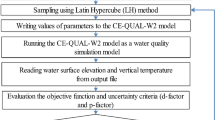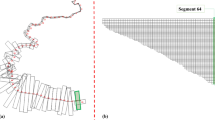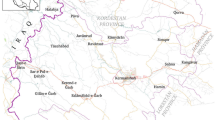Abstract
An automatic calibration of water quality model is developed in this research. Automatic calibration as the process to determine the parameters appearing in the equations of a 2-dimensional, hydrodynamic, and water quality models (CE-QUAL-W2) is carried out with Particle Swarm technique as an optimization tool. In the calibration of the CE-QUAl-W2 model, evaporation as a significant parameter influences the thermal profile and water surface elevation in reservoir, simultaneously. Therefore to consider the simultaneous effects of the water temperature variations on water surface elevation in the reservoir, a multi objective technique is used to minimize the weighted sum of total deviations of temperature from field data at check points on monitoring days and those of water surface elevation on daily monitoring period. The proposed approach overcomes the high computational efforts required if a conventional calibration search technique was used, while retaining the quality of the final calibration results. The automatic calibration approach is applied in temperature and water budget calibration of Karkheh reservoir in Iran. Applying the proposed automatic calibration approach, shows the produced results by the CE-QUAL-W2 model with the calibrated coefficients agree closely with a set of field data.
Similar content being viewed by others
References
Ababneh JI, Bataineh MH (2008) Linear phase FIR filter design using particle swarm optimization and genetic algorithms. Digit Signal Process 18:657–668
Afshar MH, Rajabpour R (2009) Application of local and global particle swarm optimization algorihtms to optimal design and operation of irrigation pumping systems. Irrig Drain 58:321–331
Afshar A, Saadatpour M (2009) Reservoir eutrophication modelling, sensitivity analysis, and assessment; application to Karkheh Reservoir, Iran. J Environ Eng Sci 26(7):1227-1238
Ambrose RB, Wool TA, Connolly JP, Schanz RW (1987) WASP4, a hydrodynamic and water quality model-model theory, user’s manual, and programmers’ guide. by Environmental Research Laboratory, Office of Research and Development, U.S. Environmental Protection Agency in Athens, Ga. EPA/600/3-87/039
Baker T, Dycus D (2004) Use of monitoring information to identify and implement water quality improvement. In: National monitoring conference, Chattanooga, TN, 17–20 May
Berger C, Wells S, Wells V (2009) Spokane river modeling report 2009, model development and calibration check. Technical Report EWR-03-09
Chau K (2005) A split-step PSO algorithm in prediction of water quality pollution: advances in Neural Networks. Lect Notes Comput Sci 3498:1034–1039
Chaudhury RR, Sobrinho JAH, Wright RM, Sreenivas M (1998) Dissolved oxygen modeling of the Blackstone River (Northeastern United States). Water Res 32(8):2400–2412
Cheng CT, Ou CP, Chau KW (2002) Combining a fuzzy optimal model with a genetic algorithm to solve multiobjective rainfall-runoff model calibration. J Hydrol 268:72–86
Chung SW, Oh JK (2006) Calibration of CE-QUAL-W2 for a monomictic reservoir in a monsoon climate area. Water Sci Technol 54:29–37
Cole TM, Tillman DH (1999) Water quality modeling of Lake Monroe using CE-QUAL-W2. U.S. Army Engineer District, Louisville, 40201-0059
Cole TM, Wells SA (2000) CE-QUAl-W2: a two-dimensional, laterally averaged, hydrodynamic and water quality model, version 3.0. Instruction Report EL-2000, US Army Engineering and Research Development Center, Vicksburg
Deb K (2001) Multi objective optimization using evolutionary algorithms. Wiley, New York
Debele B, Srinivasan R, Parlange JY (2008) Coupling upland watershed and downstream water body hydrodynamic and water quality models (SWAT and CE-QUAL-W2) for better water resources management in complex river basins. Environ Model Assess 13(1):135–153
Der Yang M, Tai Kuo J, Feng Yang Y (2000) An automatic calibration model. In: 4th international conference on integrating GIS and environmental modeling (GIS/EM4): problems, prospects and research needs. Banff, Alberta, Canada, 2–8 September. Application of remote sensing and GIS in water quality simulation and calibration, GIS/EM4 No. 154
Diogo PA, Fonseca M, Coelho PS, Mateus NS, Almeida MC, Rodrigues AC (2008) Reservoir phosphorous sources evaluation and water quality modeling in a transboundary watershed. Desalination 226:200–214
Drolc A, Koncan JZ, J (1996) Water quality modeling of the river Sava, Slovenia. Water Res 30(11):2587–2592
Etemad-Shahidi A, Afshar A, Alikia H, Moshfeghi H (2009) Total dissolved solid modeling; Karkheh reservoir case example. Int J Environ Res 3:671–680
Finley JR, Pintér JD, Satish MG (1998) Automatic model calibration applying global optimization techniques. Environ Model Assess 3:117–126
Gelda RK, Effler SW (2007) Testing and application of a two-dimensional hydrothermal model for a water supply reservoir: implication of sedimentation. Environ Eng Sci 6:73–84
Goktas RK, Aksoy A (2007) Calibration and verification of QUAL2E using genetic algorithm optimization. J Water Resour Plan Manage 133(2):126–136
Hassan R, Cohanim B, de Weck O (2004) A comparison of particle swarm optimization and the genetic algorithm. American Institute of Aeronautics and Astronautics, Reston
Hodges B, Dallimore C (2001) Estuary and lake computer model, ELCOM, science manual, code version 1.5.0. Centre for Water Research, University of Western Australia
Iran Water and Power Company (2006) Technical and research report, phase I, reservoir eutrophication, modelling and management; application to Karkheh Reservoir
Jaffe PR, Paniconi C (1988) Model calibration based on random environmental fluctuations. Environ Eng 114(5):1136–1145
Kazemi H (2010) Calibration of large scale water quality model (CE-QUAL-W2) by hybrid algorithm. M.Sc. thesis, Iran University of Science and Technology
Kumar DN, Reddy MJ (2007) Multipurpose reservoir operation using particle swarm optimization. J Water Resour Plan Manage 133(3):192–201
Kuo JT, Lung WS, Yang CP, Liu WC, Yang MD, Tang TS (2006) Eutrophication modelling of reservoirs in Taiwan. Environ Model Softw 21:829–844
Lin Z, Radcliffe DE, Doherty J (2004) Two-stage automatic calibration and predictive uncertainty analysis of a semi-distributed watershed model. American Geophysical Union, Fall Meeting, H43E-0406 1340h. http://adsabs.harvard.edu//abs/2004AGUFM.H43E0406L
Liu WC, Chen WB, Kimura N (2008) Impact of phosphorus load reduction on water quality in a stratified reservoir-eutrophication modeling study. Environ Monit Assess 159:393–406
Lu WZ, Fan HY, Leung AYT, Wong JCK (2002) Analysis OF pollutant levels in Central Hong Kong, applying neural network method with particle swarm optimization. Environ Monit Assess 79:217–230
Lung WS, Larson CE (1995) Water quality modeling of upper Mississippi River and Lake Pepin. J Environ Eng 121(10):691–699
Meraji SH (2004) Optimum design of flood control systems by particle swarm optimization algorithm. M.Sc. thesis, Iran University of Science and Technology
Mohamadi H (2002) Two dimentional reservoir eutrophication modelling. M.Sc. thesis, Iran University of Science and Technology
Mulligan AE, Brown LC (1998) Genetic algorithms for calibrating water quality models. J Environ Eng 124(3):202–211
Muttil N, Chau KW (2006) Neural network and genetic programming for modelling coastal algal blooms. Int J Environ Pollut 28(3):223–238
Nazif S, Karamouz M, Tabesh M, Moridi A (2010) Pressure management model for urban water distribution networks. Water Resour Manage 24:437–458
Ng AWM, Perera BJC (2000) Importance of genetic algorithm operators in river water quality model parameter optimization. In: Proceedings of the 26th hydrology and water resources symposium, Perth, Australia, pp 773–778
Nielsen EJ (2005) Algal succession and nutrient dynamics in elephant butte reservoir. M.Sc. thesis, Brigham Young University
Ostfeld A, Salomonst S (2005) A hybrid genetic—instance based learning algorithm for CE-QUAL-W2 calibration. J Hydrol 310:122–142
Panda S, Padhy NP (2007) Comparison of particle swarm optimization and genetic algorithm for TCSC-based controller design. Int J Elec Electron Eng 1:5
Pathmathevan M, Huang G, Tamai N (2001) Refined temperature modeling in Lake Yanaka by use of Secchi depth and a physically based Eddy diffusivity. Proc JSCE 677:215–219
Poeter EP, Hill MC (1997) Inverse models: a necessary next step in groundwater modeling. Ground Water 35(2):250–260
Saadatpour M, Afshar A (2005) Temperature calibration in reservoirs with genetic algorithm. In: 2th national water resources management conference, Iran, Isfahan, 23–24 January
Shen J, Kuo AY (1996) Inverse estimation of parameters for an estuarine eutrophication model. J Environ Eng 122(11):1031–1040
Shourian M, Mousavi SJ, Tahershamsi A (2008) Basin-wide water resources planning by integrating PSO algorithm and MODSIM. Water Resour Manage 22:1347–1366
Sullivan AB, Round SA (2005) Modeling hydrodynamics, temperature, and water quality in Henry Hagg Lake, Oregon, 2000-3. http://pubs.usgs.gov/sir/2004/5261
Ticlavilca AM, McKee M (2010) Multivariate Bayesian regression approach to forecast releases from a system of multiple reservoirs. Water Resour Manage 25:523–543. doi:10.1007/s11269-010-9712-y
Willey RG, Smith DJ, Duke JH (1996) Modeling water resource systems for water-quality management. J Water Res Plan Manag Div ASCE 122(3):171–179
Wood DM, Houck MH, Bell JM (1990) Automated calibration and use of stream quality simulation model. J Environ Eng 116(2):236-249
Xu Z, Godrej AN, Grizzard TJ (2007) The hydrological calibration and validation of a complexly-linked watershed–reservoir model for the Occoquan watershed, Virginia. J Hydrol 345:167–183
Yang F, Zhang C, Sun T (2008) Comparison of particle swarm optimization and genetic algorithm for HMM training. 978-1-4244-2175-6/08/, IEEE
Author information
Authors and Affiliations
Corresponding author
Rights and permissions
About this article
Cite this article
Afshar, A., Kazemi, H. & Saadatpour, M. Particle Swarm Optimization for Automatic Calibration of Large Scale Water Quality Model (CE-QUAL-W2): Application to Karkheh Reservoir, Iran. Water Resour Manage 25, 2613–2632 (2011). https://doi.org/10.1007/s11269-011-9829-7
Received:
Accepted:
Published:
Issue Date:
DOI: https://doi.org/10.1007/s11269-011-9829-7




